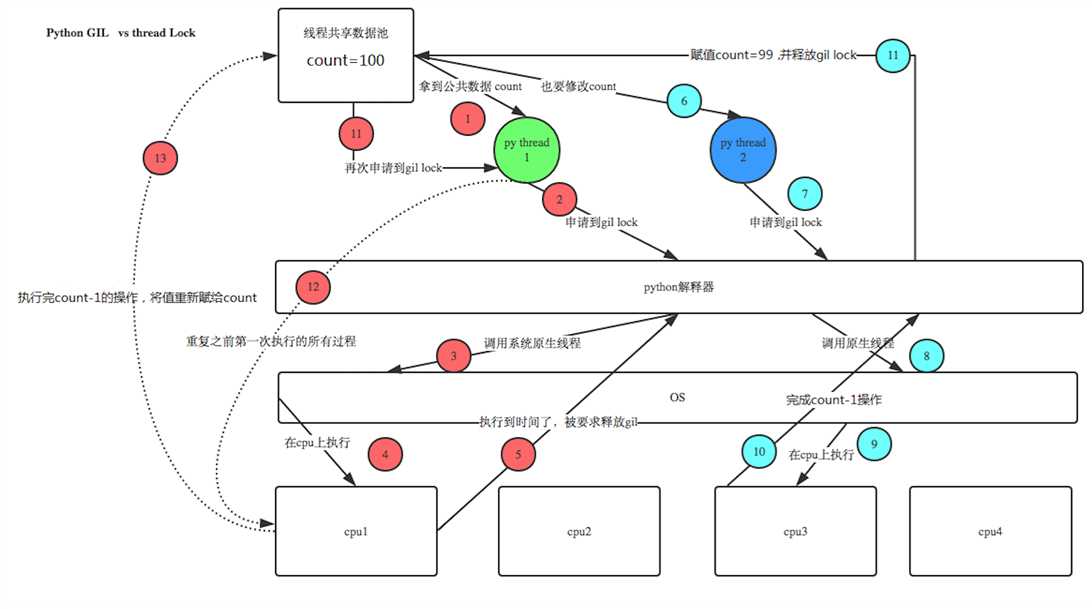多线程
Posted 11wayne
tags:
篇首语:本文由小常识网(cha138.com)小编为大家整理,主要介绍了多线程相关的知识,希望对你有一定的参考价值。
线程与进程
线程
线程是操作系统能够进行运算调度的最小单位。它被包含在进程之中,是进程中的实际运作单位。一条线程指的是进程中一个单一顺序的控制流,一个进程中可以并发多个线程,每条线程并行执行不同的任务。
进程
An executing instance of a program is called a process.
Each process provides the resources needed to execute a program. A process has a virtual address space, executable code, open handles to system objects, a security context, a unique process identifier, environment variables, a priority class, minimum and maximum working set sizes, and at least one thread of execution. Each process is started with a single thread, often called the primary thread, but can create additional threads from any of its threads.
threading模块
一 线程的2种调用方式
直接调用
import threading import time def sayhi(num): #定义每个线程要运行的函数 print("running on number:%s" %num) time.sleep(3) if __name__ == ‘__main__‘: t1 = threading.Thread(target=sayhi,args=(1,)) #生成一个线程实例 t2 = threading.Thread(target=sayhi,args=(2,)) #生成另一个线程实例 t1.start() #启动线程 t2.start() #启动另一个线程 print(t1.getName()) #获取线程名 print(t2.getName())
继承式调用
import threading import time class MyThread(threading.Thread): def __init__(self,num): threading.Thread.__init__(self) self.num = num def run(self):#定义每个线程要运行的函数 print("running on number:%s" %self.num) time.sleep(3) if __name__ == ‘__main__‘: t1 = MyThread(1) t2 = MyThread(2) t1.start() t2.start()
join与Daemon
setDaemon(True):
将线程声明为守护线程,必须在start() 方法调用之前设置, 如果不设置为守护线程程序会被无限挂起。这个方法基本和join是相反的。当我们 在程序运行中,执行一个主线程,如果主线程又创建一个子线程,主线程和子线程 就分兵两路,分别运行,那么当主线程完成想退出时,会检验子线程是否完成。如 果子线程未完成,则主线程会等待子线程完成后再退出。但是有时候我们需要的是 只要主线程完成了,不管子线程是否完成,都要和主线程一起退出,这时就可以 用setDaemon方法啦
join():
在子线程完成运行之前,这个子线程的父线程将一直被阻塞。
import threading from time import ctime,sleep import time def music(func): for i in range(2): print ("Begin listening to %s. %s" %(func,ctime())) sleep(4) print("end listening %s"%ctime()) def move(func): for i in range(2): print ("Begin watching at the %s! %s" %(func,ctime())) sleep(5) print(‘end watching %s‘%ctime()) threads = [] t1 = threading.Thread(target=music,args=(‘七里香‘,)) threads.append(t1) t2 = threading.Thread(target=move,args=(‘阿甘正传‘,)) threads.append(t2) if __name__ == ‘__main__‘: for t in threads: # t.setDaemon(True) t.start() # t.join() # t1.join() t2.join()########考虑这三种join位置下的结果? print ("all over %s" %ctime())
同步锁

#同步锁 import time import threading
#位于lock.acquire()和lock.release()之间的内容会在一次线程完成后再进行下一次进程
def addNum(): global num #在每个线程中都获取这个全局变量 # num-=1 lock.acquire() temp=num print(‘--get num:‘,num ) #time.sleep(0.1) num =temp-1 #对此公共变量进行-1操作 lock.release() num = 100 #设定一个共享变量 thread_list = [] lock=threading.Lock() for i in range(100): t = threading.Thread(target=addNum) t.start() thread_list.append(t) for t in thread_list: #等待所有线程执行完毕 t.join() print(‘final num:‘, num )
同步锁与GIL的关系?
Python的线程在GIL的控制之下,线程之间,对整个python解释器,对python提供的C API的访问都是互斥的,这可以看作是Python内核级的互斥机制。但是这种互斥是我们不能控制的,我们还需要另外一种可控的互斥机制———用户级互斥。内核级通过互斥保护了内核的共享资源,同样,用户级互斥保护了用户程序中的共享资源。
但是如果你有个操作比如 x += 1,这个操作需要多个bytecodes操作,在执行这个操作的多条bytecodes期间的时候可能中途就换thread了,这样就出现了data races的情况了。
死锁和递归锁
在线程间共享多个资源的时候,如果两个线程分别占有一部分资源并且同时等待对方的资源,就会造成死锁,因为系统判断这部分资源都正在使用,所有这两个线程在无外力作用下将一直等待下去。下面是一个死锁的例子:
import threading,time class myThread(threading.Thread): def doA(self): lockA.acquire() print(self.name,"gotlockA",time.ctime()) time.sleep(3) lockB.acquire() print(self.name,"gotlockB",time.ctime()) lockB.release() lockA.release() def doB(self): lockB.acquire() print(self.name,"gotlockB",time.ctime()) time.sleep(2) lockA.acquire() print(self.name,"gotlockA",time.ctime()) lockA.release() lockB.release() def run(self): self.doA() self.doB() if __name__=="__main__": lockA=threading.Lock() lockB=threading.Lock() threads=[] for i in range(5): threads.append(myThread()) for t in threads: t.start() for t in threads: t.join()#等待线程结束,后面再讲。
解决办法:使用递归锁,将
lockA=threading.Lock()
lockB=threading.Lock()<br>#--------------<br>lock=threading.RLock()为了支持在同一线程中多次请求同一资源,python提供了“可重入锁”:threading.RLock。RLock内部维护着一个Lock和一个counter变量,counter记录了acquire的次数,从而使得资源可以被多次acquire。直到一个线程所有的acquire都被release,其他的线程才能获得资源。
应用
import time import threading class Account: def __init__(self, _id, balance): self.id = _id self.balance = balance self.lock = threading.RLock() def withdraw(self, amount): with self.lock: self.balance -= amount def deposit(self, amount): with self.lock: self.balance += amount def drawcash(self, amount):#lock.acquire中嵌套lock.acquire的场景 with self.lock: interest=0.05 count=amount+amount*interest self.withdraw(count) def transfer(_from, to, amount): #锁不可以加在这里 因为其他的其它线程执行的其它方法在不加锁的情况下数据同样是不安全的 _from.withdraw(amount) to.deposit(amount) alex = Account(‘alex‘,1000) yuan = Account(‘yuan‘,1000) t1=threading.Thread(target = transfer, args = (alex,yuan, 100)) t1.start() t2=threading.Thread(target = transfer, args = (yuan,alex, 200)) t2.start() t1.join() t2.join() print(‘>>>‘,alex.balance) print(‘>>>‘,yuan.balance)
信号量(Semaphore)
信号量用来控制线程并发数的,BoundedSemaphore或Semaphore管理一个内置的计数器,每当调用acquire()时-1,调用release()时+1。
计数器不能小于0,当计数器为 0时,acquire()将阻塞线程至同步锁定状态,直到其他线程调用release()。(类似于停车位的概念)
BoundedSemaphore与Semaphore的唯一区别在于前者将在调用release()时检查计数 器的值是否超过了计数器的初始值,如果超过了将抛出一个异常。
实例:
#信号量 import threading,time class myThread(threading.Thread): def run(self): if semaphore.acquire(): print(self.name) time.sleep(5) semaphore.release() if __name__=="__main__": #信号量,创建5个“车位” semaphore=threading.BoundedSemaphore(5) thrs=[] for i in range(100): thrs.append(myThread()) for t in thrs: t.start()
条件变量同步(Condition)
有一类线程需要满足条件之后才能够继续执行,Python提供了threading.Condition 对象用于条件变量线程的支持,它除了能提供RLock()或Lock()的方法外,还提供了 wait()、notify()、notifyAll()方法。
lock_con=threading.Condition([Lock/Rlock]): 锁是可选选项,不传人锁,对象自动创建一个RLock()。
-
wait():条件不满足时调用,线程会释放锁并进入等待阻塞; -
notify():条件创造后调用,通知等待池激活一个线程; -
notifyAll():条件创造后调用,通知等待池激活所有线程。
#条件变量 import threading,time from random import randint class Producer(threading.Thread): def run(self): global L while True: val=randint(0,100) print(‘生产者‘,self.name,":Append"+str(val),L) if lock_con.acquire(): L.append(val) lock_con.notify()#2、通知上一个线程开始工作 lock_con.release() time.sleep(3) class Consumer(threading.Thread): def run(self): global L while True: lock_con.acquire()#3、得到notify通知后,从这里开始工作 if len(L)==0: lock_con.wait()#1、开始等待另一个线程运行,直到得到通知 print(‘消费者‘,self.name,":Delete"+str(L[0]),L) del L[0] lock_con.release() time.sleep(0.25) if __name__=="__main__": L=[] lock_con=threading.Condition() threads=[] for i in range(5): threads.append(Producer()) threads.append(Consumer()) for t in threads: t.start() for t in threads: t.join()
同步条件(Event)
条件同步和条件变量同步差不多意思,只是少了锁功能,因为条件同步设计于不访问共享资源的条件环境。event=threading.Event():条件环境对象,初始值 为False;
- event.isSet():返回event的状态值;
- event.wait():如果 event.isSet()==False将阻塞线程;
- event.set(): 设置event的状态值为True,所有阻塞池的线程激活进入就绪状态, 等待操作系统调度;
- event.clear():恢复event的状态值为False。
#同步条件event import threading,time class Boss(threading.Thread): def run(self): print("BOSS:今晚大家都要加班到22:00。") event.isSet() or event.set() #将标志位设成True time.sleep(5) print("BOSS:<22:00>可以下班了。") event.isSet() or event.set() class Worker(threading.Thread): def run(self): event.wait() #等待将标志位设为True print("Worker:哎……命苦啊!") time.sleep(0.25) event.clear() event.wait() print("Worker:OhYeah!") if __name__=="__main__": event=threading.Event() threads=[] for i in range(5): threads.append(Worker()) threads.append(Boss()) for t in threads: t.start() for t in threads: t.join()
多线程利器(queue)队列
创建一个“队列”对象
import Queue
q = Queue.Queue(maxsize = 10)
Queue.Queue类即是一个队列的同步实现。队列长度可为无限或者有限。可通过Queue的构造函数的可选参数maxsize来设定队列长度。如果maxsize小于1就表示队列长度无限。
将一个值放入队列中
q.put(10)
调用队列对象的put()方法在队尾插入一个项目。put()有两个参数,第一个item为必需的,为插入项目的值;第二个block为可选参数,默认为
1。如果队列当前为空且block为1,put()方法就使调用线程暂停,直到空出一个数据单元。如果block为0,put方法将引发Full异常。
将一个值从队列中取出
q.get()
调用队列对象的get()方法从队头删除并返回一个项目。可选参数为block,默认为True。如果队列为空且block为True,get()就使调用线程暂停,直至有项目可用。如果队列为空且block为False,队列将引发Empty异常。
Python Queue模块有三种队列及构造函数:
1、Python Queue模块的FIFO队列先进先出。 class queue.Queue(maxsize)
2、LIFO类似于堆,即先进后出。 class queue.LifoQueue(maxsize)
3、还有一种是优先级队列级别越低越先出来。 class queue.PriorityQueue(maxsize)
此包中的常用方法(q = Queue.Queue()):
q.qsize() 返回队列的大小
q.empty() 如果队列为空,返回True,反之False
q.full() 如果队列满了,返回True,反之False
q.full 与 maxsize 大小对应
q.get([block[, timeout]]) 获取队列,timeout等待时间
q.get_nowait() 相当q.get(False)
非阻塞 q.put(item) 写入队列,timeout等待时间
q.put_nowait(item) 相当q.put(item, False)
q.task_done() 在完成一项工作之后,q.task_done() 函数向任务已经完成的队列发送一个信号
q.join() 实际上意味着等到队列为空,再执行别的操作
以上是关于多线程的主要内容,如果未能解决你的问题,请参考以下文章